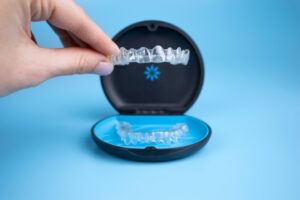
Invisalign has revolutionized orthodontics by offering a clear, removable, and more discreet alternative to traditional braces. It’s an excellent solution for many people looking to straighten their teeth comfortably and conveniently. But like any dental or medical treatment, Invisalign isn’t entirely without risk. Understanding the potential complications can help you stay on track and minimize problems during your treatment. Here are some possible complications with Invisalign and tips on how to manage or avoid them.
Discomfort and Pressure
While Invisalign is generally more comfortable than metal braces, it’s normal to experience mild discomfort or pressure, especially when switching to a new set of aligners. This sensation usually fades after a day or two, but it can be bothersome for some patients.
What to do: Over-the-counter pain relievers and wearing your aligners consistently can help your teeth adjust more quickly. Chewing on Invisalign “chewies” can also improve fit and reduce soreness.
Speech Difficulties
Some patients report a slight lisp or speech change when they first begin wearing Invisalign. This happens because the aligners take up space in your mouth and may interfere with tongue placement.
What to do: The issue typically resolves within a few days as you get used to the aligners. Practicing speaking or reading out loud can help speed up the adjustment.
Aligner Fit Issues
Occasionally, aligners may not fit properly or fail to move teeth as expected. This can happen due to missed wear time, complex tooth movements, or natural variations in tooth response.
What to do: Be honest about how long you wear your aligners each day (the recommended time is 20 to 22 hours). If you notice a poor fit, contact your provider; additional attachments or refinements may be needed.
Dry Mouth or Excess Saliva
Wearing aligners can affect your saliva flow, either causing dry mouth or an increase in saliva production. Both can be uncomfortable and lead to oral health issues if not managed.
What to do: Stay hydrated, practice good oral hygiene, and ask your dentist about mouth rinses or treatments to relieve symptoms.
Tooth or Gum Sensitivity
Because Invisalign gradually shifts your teeth, it can sometimes lead to temporary tooth sensitivity or sore gums. This is especially noticeable when a new tray is introduced.
What to do: Use a soft-bristled toothbrush and toothpaste for sensitive teeth. If pain persists, consult your dentist to ensure there’s no underlying problem.
Lost or Damaged Aligners
Aligners are clear and easy to misplace or damage if not handled properly. Losing one can delay your treatment and create fitting issues.
What to do: Always store your aligners in their case when not in use, and bring your previous set with you when traveling. If you lose a tray, contact your provider immediately for guidance.
Invisalign is a fantastic option for many patients, but like any treatment, it comes with potential complications. Most issues are minor and manageable with good habits and regular communication with your dental provider. Staying informed and proactive is the best way to ensure a smooth, successful Invisalign journey, and a straighter, healthier smile at the end.
About the Author
Dr. Wayne Zayland Berry graduated Magna Cum Laude from Virginia Commonwealth University with his Doctor of Dental Surgery (DDS). After graduating, he completed a residency in Advanced Education in General Dentistry at the Langley Air Force Base. Today, Dr. Berry is a member of the American Dental Association, the Academy of General Dentistry, and the American Association of Orthodontists. If you’d like to straighten out your smile with Invisalign treatment, Dr. Berry and our team of experts can help! Schedule your appointment online today or call our office at (757) 548-1611.
